Palliative Case Study: Management of Increased Risk of Infection in Breast Cancer Patient
VerifiedAdded on 2023/01/13
|9
|2414
|59
AI Summary
This case study focuses on the management of increased risk of infection in a breast cancer patient. It discusses the nursing assessment using the Corbin and Strauss Illness Trajectory Model, critical thinking in decision making and care planning, and factors that may hinder or facilitate goals. The study also explores the micro, meso, and macro factors that contribute to the management of the case.
Contribute Materials
Your contribution can guide someone’s learning journey. Share your
documents today.

Palliative Case Study
1
1
Secure Best Marks with AI Grader
Need help grading? Try our AI Grader for instant feedback on your assignments.
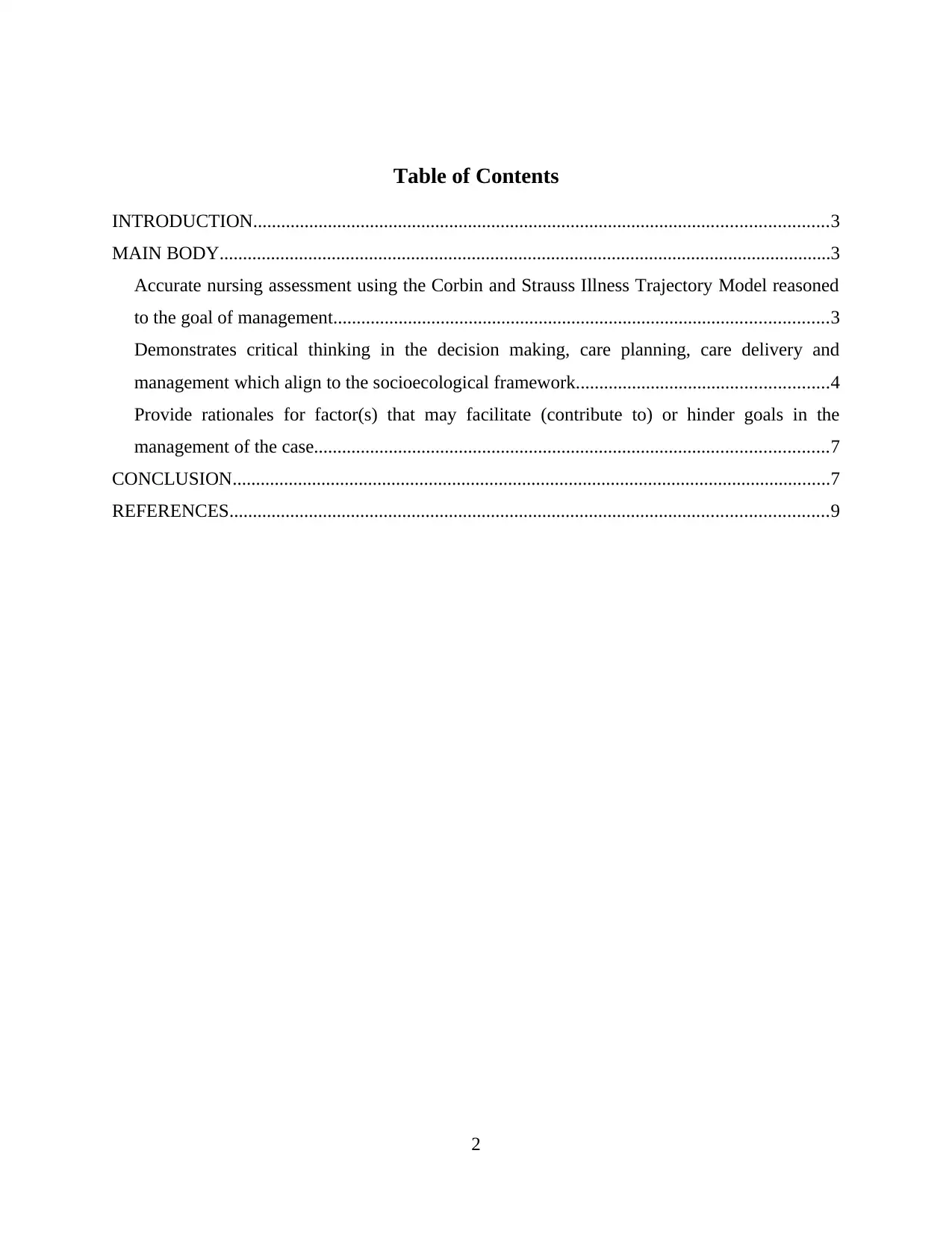
Table of Contents
INTRODUCTION...........................................................................................................................3
MAIN BODY...................................................................................................................................3
Accurate nursing assessment using the Corbin and Strauss Illness Trajectory Model reasoned
to the goal of management..........................................................................................................3
Demonstrates critical thinking in the decision making, care planning, care delivery and
management which align to the socioecological framework......................................................4
Provide rationales for factor(s) that may facilitate (contribute to) or hinder goals in the
management of the case..............................................................................................................7
CONCLUSION................................................................................................................................7
REFERENCES................................................................................................................................9
2
INTRODUCTION...........................................................................................................................3
MAIN BODY...................................................................................................................................3
Accurate nursing assessment using the Corbin and Strauss Illness Trajectory Model reasoned
to the goal of management..........................................................................................................3
Demonstrates critical thinking in the decision making, care planning, care delivery and
management which align to the socioecological framework......................................................4
Provide rationales for factor(s) that may facilitate (contribute to) or hinder goals in the
management of the case..............................................................................................................7
CONCLUSION................................................................................................................................7
REFERENCES................................................................................................................................9
2
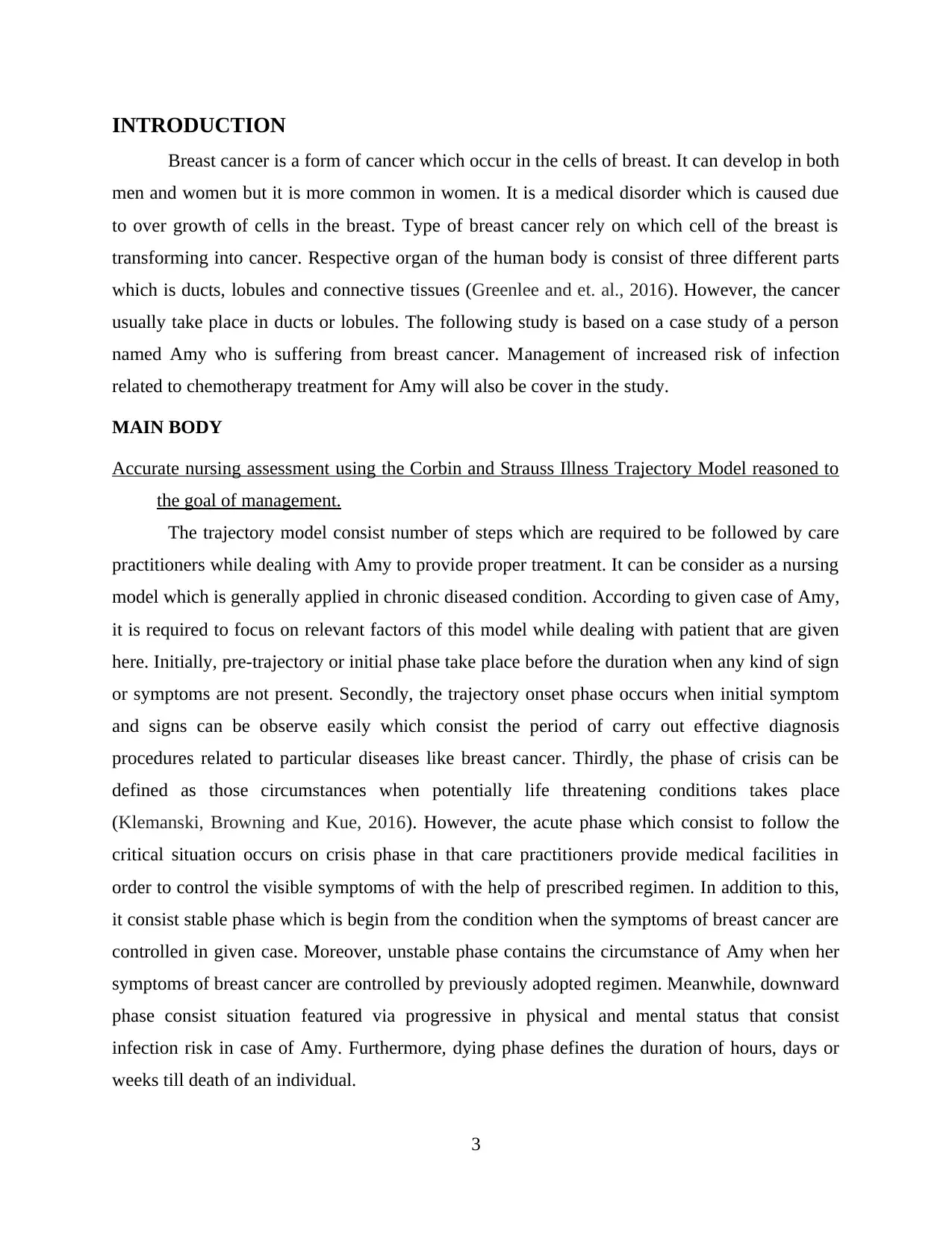
INTRODUCTION
Breast cancer is a form of cancer which occur in the cells of breast. It can develop in both
men and women but it is more common in women. It is a medical disorder which is caused due
to over growth of cells in the breast. Type of breast cancer rely on which cell of the breast is
transforming into cancer. Respective organ of the human body is consist of three different parts
which is ducts, lobules and connective tissues (Greenlee and et. al., 2016). However, the cancer
usually take place in ducts or lobules. The following study is based on a case study of a person
named Amy who is suffering from breast cancer. Management of increased risk of infection
related to chemotherapy treatment for Amy will also be cover in the study.
MAIN BODY
Accurate nursing assessment using the Corbin and Strauss Illness Trajectory Model reasoned to
the goal of management.
The trajectory model consist number of steps which are required to be followed by care
practitioners while dealing with Amy to provide proper treatment. It can be consider as a nursing
model which is generally applied in chronic diseased condition. According to given case of Amy,
it is required to focus on relevant factors of this model while dealing with patient that are given
here. Initially, pre-trajectory or initial phase take place before the duration when any kind of sign
or symptoms are not present. Secondly, the trajectory onset phase occurs when initial symptom
and signs can be observe easily which consist the period of carry out effective diagnosis
procedures related to particular diseases like breast cancer. Thirdly, the phase of crisis can be
defined as those circumstances when potentially life threatening conditions takes place
(Klemanski, Browning and Kue, 2016). However, the acute phase which consist to follow the
critical situation occurs on crisis phase in that care practitioners provide medical facilities in
order to control the visible symptoms of with the help of prescribed regimen. In addition to this,
it consist stable phase which is begin from the condition when the symptoms of breast cancer are
controlled in given case. Moreover, unstable phase contains the circumstance of Amy when her
symptoms of breast cancer are controlled by previously adopted regimen. Meanwhile, downward
phase consist situation featured via progressive in physical and mental status that consist
infection risk in case of Amy. Furthermore, dying phase defines the duration of hours, days or
weeks till death of an individual.
3
Breast cancer is a form of cancer which occur in the cells of breast. It can develop in both
men and women but it is more common in women. It is a medical disorder which is caused due
to over growth of cells in the breast. Type of breast cancer rely on which cell of the breast is
transforming into cancer. Respective organ of the human body is consist of three different parts
which is ducts, lobules and connective tissues (Greenlee and et. al., 2016). However, the cancer
usually take place in ducts or lobules. The following study is based on a case study of a person
named Amy who is suffering from breast cancer. Management of increased risk of infection
related to chemotherapy treatment for Amy will also be cover in the study.
MAIN BODY
Accurate nursing assessment using the Corbin and Strauss Illness Trajectory Model reasoned to
the goal of management.
The trajectory model consist number of steps which are required to be followed by care
practitioners while dealing with Amy to provide proper treatment. It can be consider as a nursing
model which is generally applied in chronic diseased condition. According to given case of Amy,
it is required to focus on relevant factors of this model while dealing with patient that are given
here. Initially, pre-trajectory or initial phase take place before the duration when any kind of sign
or symptoms are not present. Secondly, the trajectory onset phase occurs when initial symptom
and signs can be observe easily which consist the period of carry out effective diagnosis
procedures related to particular diseases like breast cancer. Thirdly, the phase of crisis can be
defined as those circumstances when potentially life threatening conditions takes place
(Klemanski, Browning and Kue, 2016). However, the acute phase which consist to follow the
critical situation occurs on crisis phase in that care practitioners provide medical facilities in
order to control the visible symptoms of with the help of prescribed regimen. In addition to this,
it consist stable phase which is begin from the condition when the symptoms of breast cancer are
controlled in given case. Moreover, unstable phase contains the circumstance of Amy when her
symptoms of breast cancer are controlled by previously adopted regimen. Meanwhile, downward
phase consist situation featured via progressive in physical and mental status that consist
infection risk in case of Amy. Furthermore, dying phase defines the duration of hours, days or
weeks till death of an individual.
3

On the other hand, this nursing model is required to be applied in case of Amy in terms of
conducting management of increased risk of infection related to chemotherapy. It includes the
several steps which should be followed to determine relevant problems and symptoms of given
patients in order to provide correct treatment for making them well-being. Meanwhile, these
activities have a correct sequence according which it is required to be conduct in case of Amy
which are explained further:
Identifying the trajectory phase: In case of given patient, it is required to identify the
relevant symptoms of breast cancer and infection related to chemotherapy. It is necessary to
determine these signs along with carrying out diagnosing procedures to examine causes behind
them which are needed to be treated by appropriate treatment techniques (Gorman and et. al.,
2018).
Identifying problems and establishing goals: Amy is suffering from breast cancer for
which physicians has started a cycle of chemotherapy for treating the health issue. It consist the
problem of increase risk of infection related to chemotherapy. The goal is to reduce the risk of
occurring infection caused by the process of chemotherapy.
Establishing plans to meet goals: This includes more effective as well as efficient
interventions with rationale which are required to be followed step by step to achieve goal of
making patient free with risk of infection.
Identifying factors that facilitate or hinder attainment of goals: The support of care
professionals family members of Amy facilitate to make her well-being.
Implementing interventions: The nursing interventions should be applied by consider the
all important factors to gain better patient outcomes (Mayer, 2016).
Evaluating the effectiveness of interventions: The care practitioners are required to
monitor condition of Amy after provide medical facilities to evaluate effectiveness of
implemented interventions.
Demonstrates critical thinking in the decision making, care planning, care delivery and
management which align to the socioecological framework.
According to the case of Amy, the decision making can be done through diagnosis and
visible symptoms of patients in order to provide proper care to them. It includes to apply number
of interventions to reduce risk of infection related to chemotherapy and deliver care services to
selected individual by considering factors such as MICRO, MESO and MACRO to gain better
4
conducting management of increased risk of infection related to chemotherapy. It includes the
several steps which should be followed to determine relevant problems and symptoms of given
patients in order to provide correct treatment for making them well-being. Meanwhile, these
activities have a correct sequence according which it is required to be conduct in case of Amy
which are explained further:
Identifying the trajectory phase: In case of given patient, it is required to identify the
relevant symptoms of breast cancer and infection related to chemotherapy. It is necessary to
determine these signs along with carrying out diagnosing procedures to examine causes behind
them which are needed to be treated by appropriate treatment techniques (Gorman and et. al.,
2018).
Identifying problems and establishing goals: Amy is suffering from breast cancer for
which physicians has started a cycle of chemotherapy for treating the health issue. It consist the
problem of increase risk of infection related to chemotherapy. The goal is to reduce the risk of
occurring infection caused by the process of chemotherapy.
Establishing plans to meet goals: This includes more effective as well as efficient
interventions with rationale which are required to be followed step by step to achieve goal of
making patient free with risk of infection.
Identifying factors that facilitate or hinder attainment of goals: The support of care
professionals family members of Amy facilitate to make her well-being.
Implementing interventions: The nursing interventions should be applied by consider the
all important factors to gain better patient outcomes (Mayer, 2016).
Evaluating the effectiveness of interventions: The care practitioners are required to
monitor condition of Amy after provide medical facilities to evaluate effectiveness of
implemented interventions.
Demonstrates critical thinking in the decision making, care planning, care delivery and
management which align to the socioecological framework.
According to the case of Amy, the decision making can be done through diagnosis and
visible symptoms of patients in order to provide proper care to them. It includes to apply number
of interventions to reduce risk of infection related to chemotherapy and deliver care services to
selected individual by considering factors such as MICRO, MESO and MACRO to gain better
4
Secure Best Marks with AI Grader
Need help grading? Try our AI Grader for instant feedback on your assignments.
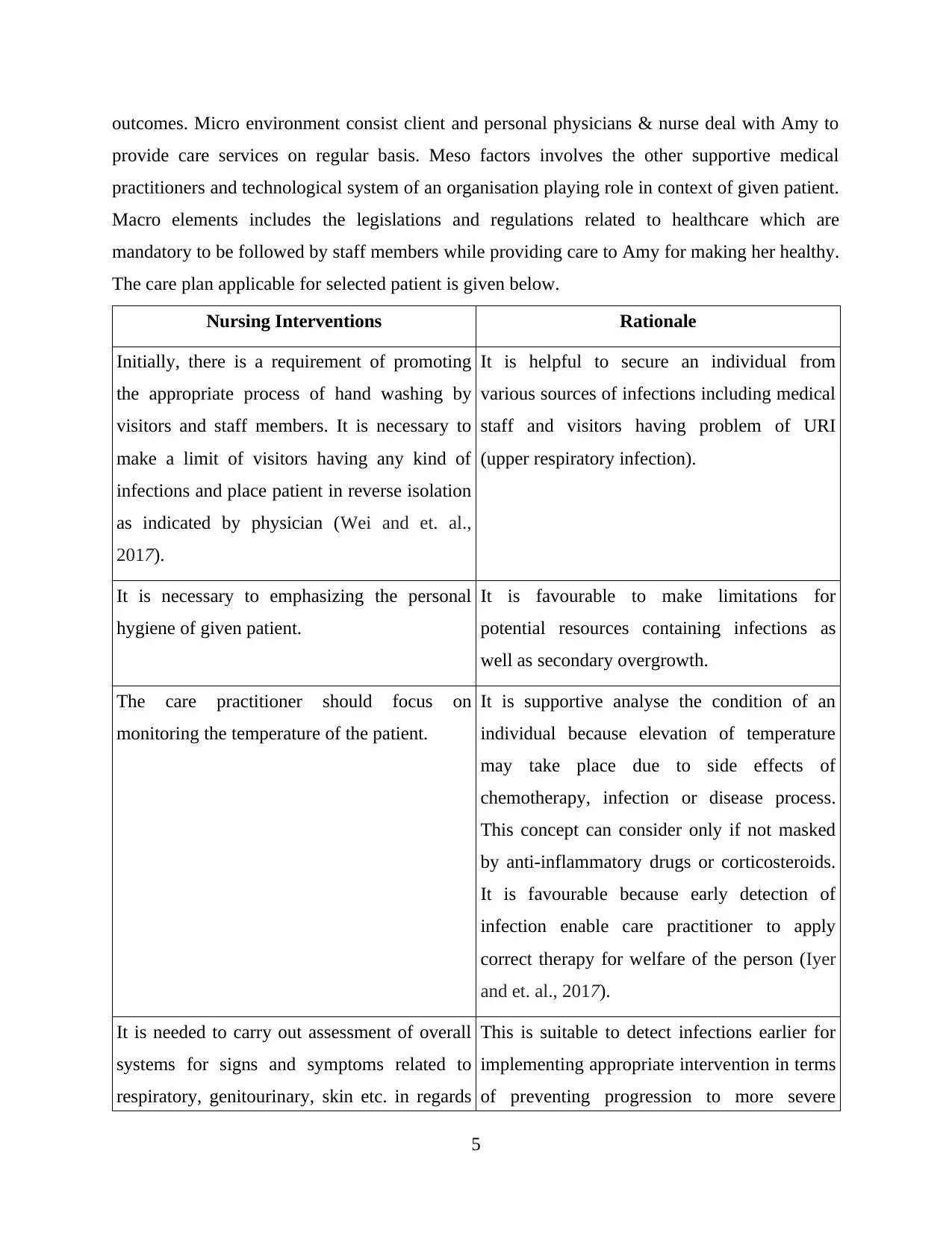
outcomes. Micro environment consist client and personal physicians & nurse deal with Amy to
provide care services on regular basis. Meso factors involves the other supportive medical
practitioners and technological system of an organisation playing role in context of given patient.
Macro elements includes the legislations and regulations related to healthcare which are
mandatory to be followed by staff members while providing care to Amy for making her healthy.
The care plan applicable for selected patient is given below.
Nursing Interventions Rationale
Initially, there is a requirement of promoting
the appropriate process of hand washing by
visitors and staff members. It is necessary to
make a limit of visitors having any kind of
infections and place patient in reverse isolation
as indicated by physician (Wei and et. al.,
2017).
It is helpful to secure an individual from
various sources of infections including medical
staff and visitors having problem of URI
(upper respiratory infection).
It is necessary to emphasizing the personal
hygiene of given patient.
It is favourable to make limitations for
potential resources containing infections as
well as secondary overgrowth.
The care practitioner should focus on
monitoring the temperature of the patient.
It is supportive analyse the condition of an
individual because elevation of temperature
may take place due to side effects of
chemotherapy, infection or disease process.
This concept can consider only if not masked
by anti-inflammatory drugs or corticosteroids.
It is favourable because early detection of
infection enable care practitioner to apply
correct therapy for welfare of the person (Iyer
and et. al., 2017).
It is needed to carry out assessment of overall
systems for signs and symptoms related to
respiratory, genitourinary, skin etc. in regards
This is suitable to detect infections earlier for
implementing appropriate intervention in terms
of preventing progression to more severe
5
provide care services on regular basis. Meso factors involves the other supportive medical
practitioners and technological system of an organisation playing role in context of given patient.
Macro elements includes the legislations and regulations related to healthcare which are
mandatory to be followed by staff members while providing care to Amy for making her healthy.
The care plan applicable for selected patient is given below.
Nursing Interventions Rationale
Initially, there is a requirement of promoting
the appropriate process of hand washing by
visitors and staff members. It is necessary to
make a limit of visitors having any kind of
infections and place patient in reverse isolation
as indicated by physician (Wei and et. al.,
2017).
It is helpful to secure an individual from
various sources of infections including medical
staff and visitors having problem of URI
(upper respiratory infection).
It is necessary to emphasizing the personal
hygiene of given patient.
It is favourable to make limitations for
potential resources containing infections as
well as secondary overgrowth.
The care practitioner should focus on
monitoring the temperature of the patient.
It is supportive analyse the condition of an
individual because elevation of temperature
may take place due to side effects of
chemotherapy, infection or disease process.
This concept can consider only if not masked
by anti-inflammatory drugs or corticosteroids.
It is favourable because early detection of
infection enable care practitioner to apply
correct therapy for welfare of the person (Iyer
and et. al., 2017).
It is needed to carry out assessment of overall
systems for signs and symptoms related to
respiratory, genitourinary, skin etc. in regards
This is suitable to detect infections earlier for
implementing appropriate intervention in terms
of preventing progression to more severe
5
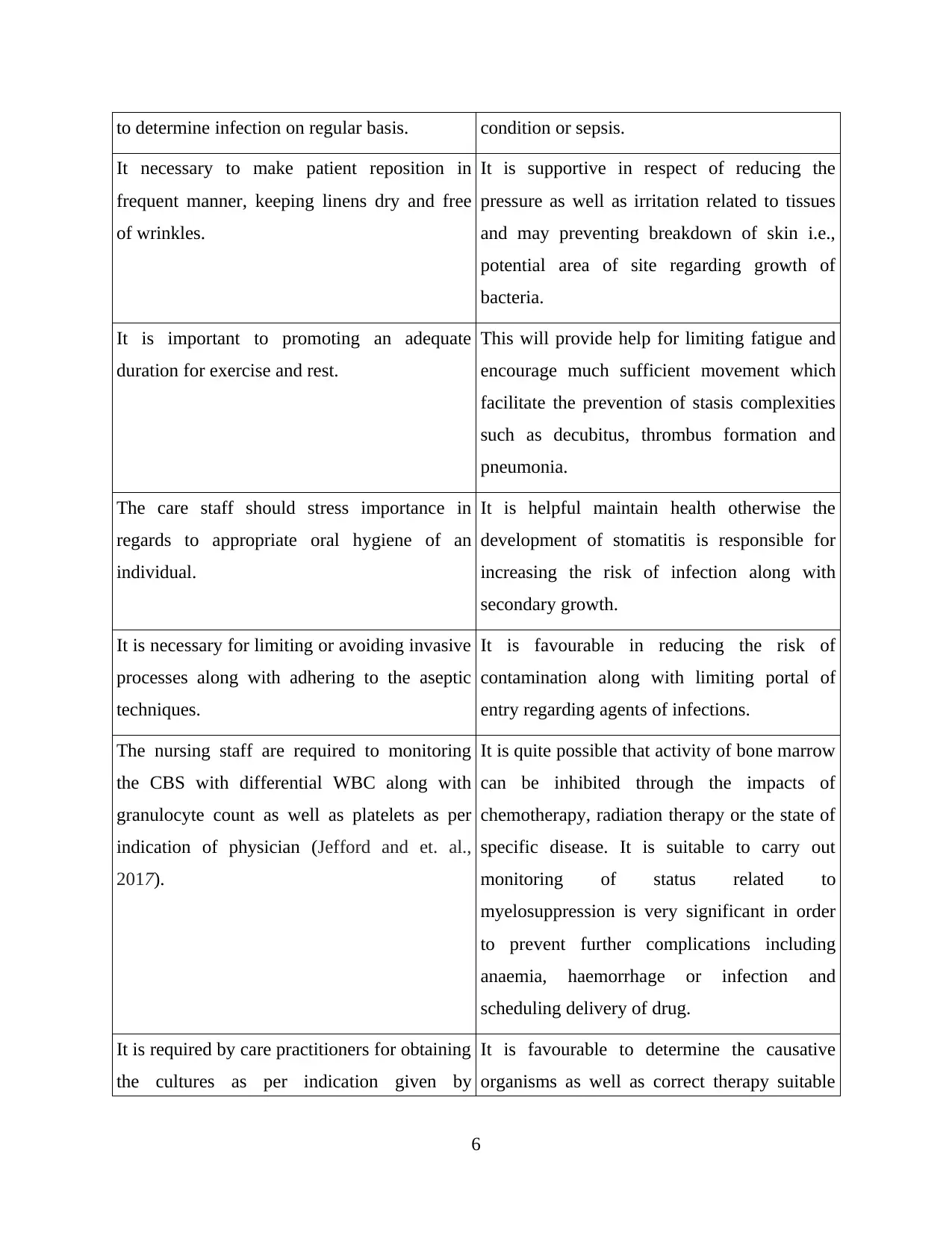
to determine infection on regular basis. condition or sepsis.
It necessary to make patient reposition in
frequent manner, keeping linens dry and free
of wrinkles.
It is supportive in respect of reducing the
pressure as well as irritation related to tissues
and may preventing breakdown of skin i.e.,
potential area of site regarding growth of
bacteria.
It is important to promoting an adequate
duration for exercise and rest.
This will provide help for limiting fatigue and
encourage much sufficient movement which
facilitate the prevention of stasis complexities
such as decubitus, thrombus formation and
pneumonia.
The care staff should stress importance in
regards to appropriate oral hygiene of an
individual.
It is helpful maintain health otherwise the
development of stomatitis is responsible for
increasing the risk of infection along with
secondary growth.
It is necessary for limiting or avoiding invasive
processes along with adhering to the aseptic
techniques.
It is favourable in reducing the risk of
contamination along with limiting portal of
entry regarding agents of infections.
The nursing staff are required to monitoring
the CBS with differential WBC along with
granulocyte count as well as platelets as per
indication of physician (Jefford and et. al.,
2017).
It is quite possible that activity of bone marrow
can be inhibited through the impacts of
chemotherapy, radiation therapy or the state of
specific disease. It is suitable to carry out
monitoring of status related to
myelosuppression is very significant in order
to prevent further complications including
anaemia, haemorrhage or infection and
scheduling delivery of drug.
It is required by care practitioners for obtaining
the cultures as per indication given by
It is favourable to determine the causative
organisms as well as correct therapy suitable
6
It necessary to make patient reposition in
frequent manner, keeping linens dry and free
of wrinkles.
It is supportive in respect of reducing the
pressure as well as irritation related to tissues
and may preventing breakdown of skin i.e.,
potential area of site regarding growth of
bacteria.
It is important to promoting an adequate
duration for exercise and rest.
This will provide help for limiting fatigue and
encourage much sufficient movement which
facilitate the prevention of stasis complexities
such as decubitus, thrombus formation and
pneumonia.
The care staff should stress importance in
regards to appropriate oral hygiene of an
individual.
It is helpful maintain health otherwise the
development of stomatitis is responsible for
increasing the risk of infection along with
secondary growth.
It is necessary for limiting or avoiding invasive
processes along with adhering to the aseptic
techniques.
It is favourable in reducing the risk of
contamination along with limiting portal of
entry regarding agents of infections.
The nursing staff are required to monitoring
the CBS with differential WBC along with
granulocyte count as well as platelets as per
indication of physician (Jefford and et. al.,
2017).
It is quite possible that activity of bone marrow
can be inhibited through the impacts of
chemotherapy, radiation therapy or the state of
specific disease. It is suitable to carry out
monitoring of status related to
myelosuppression is very significant in order
to prevent further complications including
anaemia, haemorrhage or infection and
scheduling delivery of drug.
It is required by care practitioners for obtaining
the cultures as per indication given by
It is favourable to determine the causative
organisms as well as correct therapy suitable
6
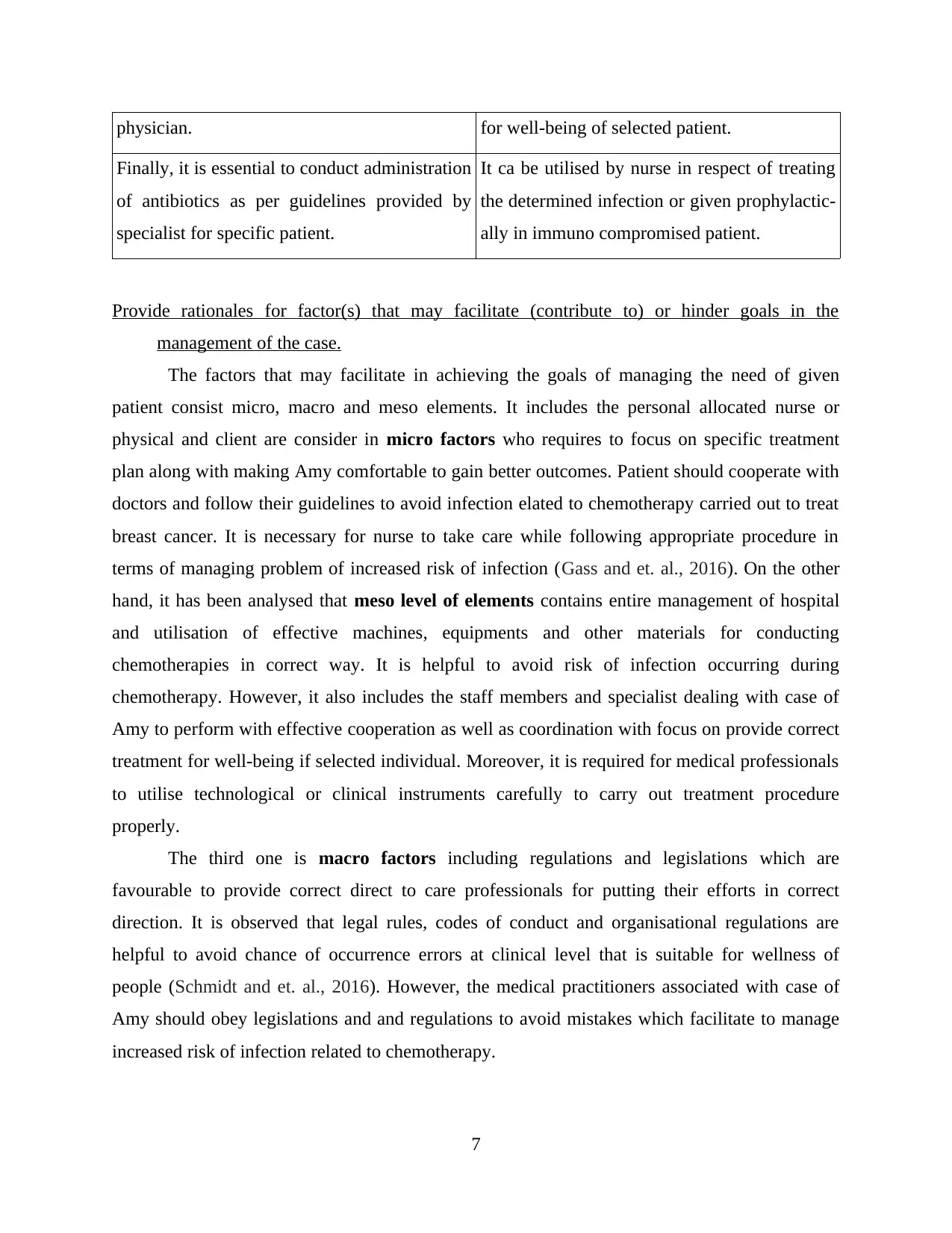
physician. for well-being of selected patient.
Finally, it is essential to conduct administration
of antibiotics as per guidelines provided by
specialist for specific patient.
It ca be utilised by nurse in respect of treating
the determined infection or given prophylactic-
ally in immuno compromised patient.
Provide rationales for factor(s) that may facilitate (contribute to) or hinder goals in the
management of the case.
The factors that may facilitate in achieving the goals of managing the need of given
patient consist micro, macro and meso elements. It includes the personal allocated nurse or
physical and client are consider in micro factors who requires to focus on specific treatment
plan along with making Amy comfortable to gain better outcomes. Patient should cooperate with
doctors and follow their guidelines to avoid infection elated to chemotherapy carried out to treat
breast cancer. It is necessary for nurse to take care while following appropriate procedure in
terms of managing problem of increased risk of infection (Gass and et. al., 2016). On the other
hand, it has been analysed that meso level of elements contains entire management of hospital
and utilisation of effective machines, equipments and other materials for conducting
chemotherapies in correct way. It is helpful to avoid risk of infection occurring during
chemotherapy. However, it also includes the staff members and specialist dealing with case of
Amy to perform with effective cooperation as well as coordination with focus on provide correct
treatment for well-being if selected individual. Moreover, it is required for medical professionals
to utilise technological or clinical instruments carefully to carry out treatment procedure
properly.
The third one is macro factors including regulations and legislations which are
favourable to provide correct direct to care professionals for putting their efforts in correct
direction. It is observed that legal rules, codes of conduct and organisational regulations are
helpful to avoid chance of occurrence errors at clinical level that is suitable for wellness of
people (Schmidt and et. al., 2016). However, the medical practitioners associated with case of
Amy should obey legislations and and regulations to avoid mistakes which facilitate to manage
increased risk of infection related to chemotherapy.
7
Finally, it is essential to conduct administration
of antibiotics as per guidelines provided by
specialist for specific patient.
It ca be utilised by nurse in respect of treating
the determined infection or given prophylactic-
ally in immuno compromised patient.
Provide rationales for factor(s) that may facilitate (contribute to) or hinder goals in the
management of the case.
The factors that may facilitate in achieving the goals of managing the need of given
patient consist micro, macro and meso elements. It includes the personal allocated nurse or
physical and client are consider in micro factors who requires to focus on specific treatment
plan along with making Amy comfortable to gain better outcomes. Patient should cooperate with
doctors and follow their guidelines to avoid infection elated to chemotherapy carried out to treat
breast cancer. It is necessary for nurse to take care while following appropriate procedure in
terms of managing problem of increased risk of infection (Gass and et. al., 2016). On the other
hand, it has been analysed that meso level of elements contains entire management of hospital
and utilisation of effective machines, equipments and other materials for conducting
chemotherapies in correct way. It is helpful to avoid risk of infection occurring during
chemotherapy. However, it also includes the staff members and specialist dealing with case of
Amy to perform with effective cooperation as well as coordination with focus on provide correct
treatment for well-being if selected individual. Moreover, it is required for medical professionals
to utilise technological or clinical instruments carefully to carry out treatment procedure
properly.
The third one is macro factors including regulations and legislations which are
favourable to provide correct direct to care professionals for putting their efforts in correct
direction. It is observed that legal rules, codes of conduct and organisational regulations are
helpful to avoid chance of occurrence errors at clinical level that is suitable for wellness of
people (Schmidt and et. al., 2016). However, the medical practitioners associated with case of
Amy should obey legislations and and regulations to avoid mistakes which facilitate to manage
increased risk of infection related to chemotherapy.
7
Paraphrase This Document
Need a fresh take? Get an instant paraphrase of this document with our AI Paraphraser
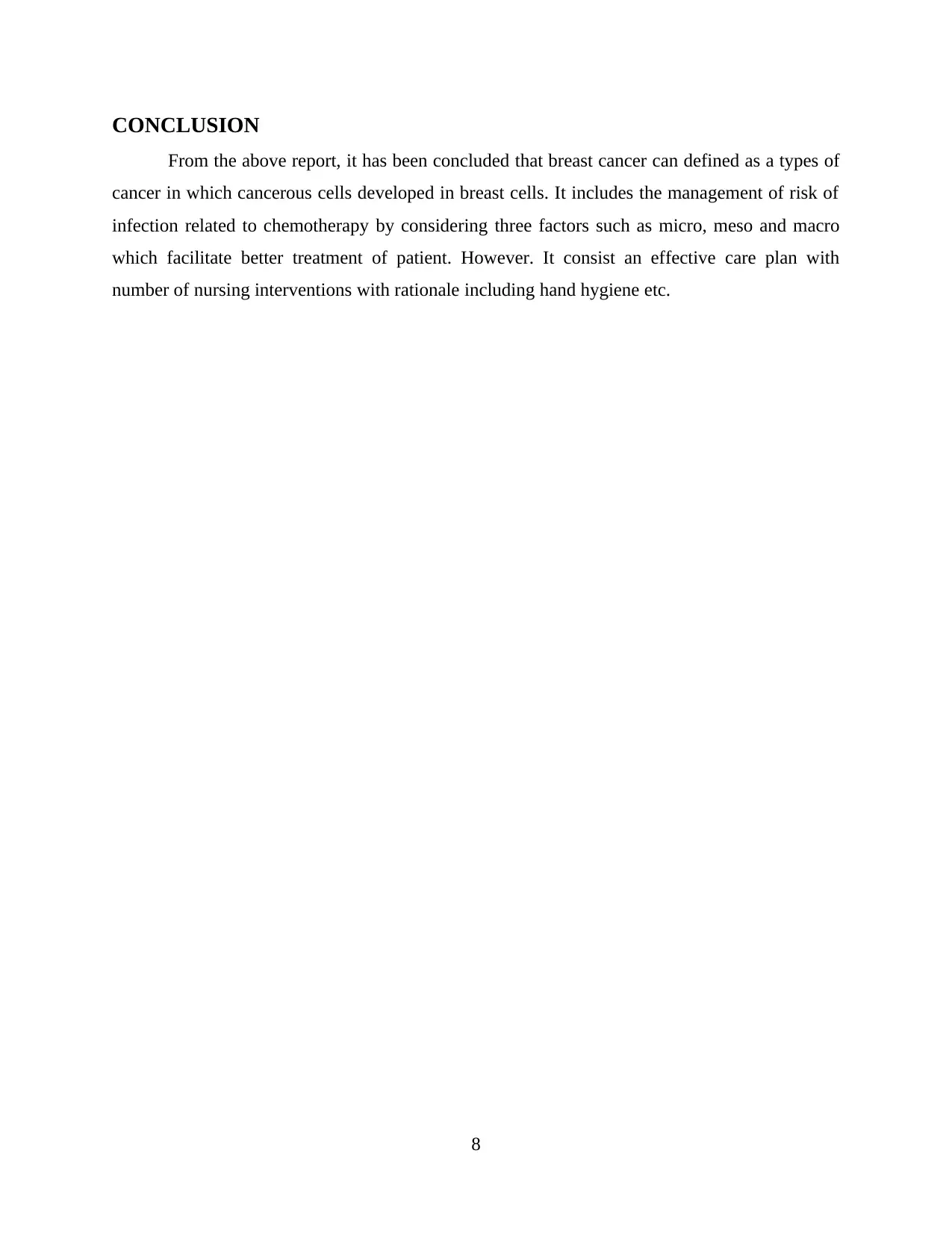
CONCLUSION
From the above report, it has been concluded that breast cancer can defined as a types of
cancer in which cancerous cells developed in breast cells. It includes the management of risk of
infection related to chemotherapy by considering three factors such as micro, meso and macro
which facilitate better treatment of patient. However. It consist an effective care plan with
number of nursing interventions with rationale including hand hygiene etc.
8
From the above report, it has been concluded that breast cancer can defined as a types of
cancer in which cancerous cells developed in breast cells. It includes the management of risk of
infection related to chemotherapy by considering three factors such as micro, meso and macro
which facilitate better treatment of patient. However. It consist an effective care plan with
number of nursing interventions with rationale including hand hygiene etc.
8

REFERENCES
Books and journals
Gass, J. and et. al., 2016. Breast cancer survivorship: why, what and when?. Annals of surgical
oncology, 23(10), pp.3162-3167.
Gorman, J.R. and et. al., 2018. Developing a post-treatment survivorship care plan to help breast
cancer survivors understand their fertility. Supportive Care in Cancer, 26(2), pp.589-
595.
Greenlee, H. and et. al., 2016. Survivorship care plans and adherence to lifestyle
recommendations among breast cancer survivors. Journal of Cancer
Survivorship, 10(6), pp.956-963.
Iyer, N.S. and et. al., 2017. Experiences with the survivorship care plan in primary care providers
of childhood cancer survivors: a mixed methods approach. Supportive Care in
Cancer, 25(5), pp.1547-1555.
Jefford, M. and et. al., 2017. Patient-reported outcomes in cancer survivors: a population-wide
cross-sectional study. Supportive Care in Cancer, 25(10), pp.3171-3179.
Klemanski, D.L., Browning, K.K. and Kue, J., 2016. Survivorship care plan preferences of
cancer survivors and health care providers: a systematic review and quality appraisal of
the evidence. Journal of Cancer Survivorship, 10(1), pp.71-86.
Mayer, D.K., 2016, September. Using Survivorship Care Plans to Enhance Communication and
Cancer Care Coordination: Results of a Pilot Study. In Oncology nursing forum (Vol.
43, No. 5).
Schmidt, A. and et. al., 2016. After initial treatment for primary breast cancer: information
needs, health literacy, and the role of health care workers. Supportive care in
cancer, 24(2), pp.563-571.
Wei, C. and et. al., 2017. The patient–provider discordance in patients’ needs assessment: a
qualitative study in breast cancer patients receiving oral chemotherapy. Journal of
clinical nursing, 26(1-2), pp.125-132.
9
Books and journals
Gass, J. and et. al., 2016. Breast cancer survivorship: why, what and when?. Annals of surgical
oncology, 23(10), pp.3162-3167.
Gorman, J.R. and et. al., 2018. Developing a post-treatment survivorship care plan to help breast
cancer survivors understand their fertility. Supportive Care in Cancer, 26(2), pp.589-
595.
Greenlee, H. and et. al., 2016. Survivorship care plans and adherence to lifestyle
recommendations among breast cancer survivors. Journal of Cancer
Survivorship, 10(6), pp.956-963.
Iyer, N.S. and et. al., 2017. Experiences with the survivorship care plan in primary care providers
of childhood cancer survivors: a mixed methods approach. Supportive Care in
Cancer, 25(5), pp.1547-1555.
Jefford, M. and et. al., 2017. Patient-reported outcomes in cancer survivors: a population-wide
cross-sectional study. Supportive Care in Cancer, 25(10), pp.3171-3179.
Klemanski, D.L., Browning, K.K. and Kue, J., 2016. Survivorship care plan preferences of
cancer survivors and health care providers: a systematic review and quality appraisal of
the evidence. Journal of Cancer Survivorship, 10(1), pp.71-86.
Mayer, D.K., 2016, September. Using Survivorship Care Plans to Enhance Communication and
Cancer Care Coordination: Results of a Pilot Study. In Oncology nursing forum (Vol.
43, No. 5).
Schmidt, A. and et. al., 2016. After initial treatment for primary breast cancer: information
needs, health literacy, and the role of health care workers. Supportive care in
cancer, 24(2), pp.563-571.
Wei, C. and et. al., 2017. The patient–provider discordance in patients’ needs assessment: a
qualitative study in breast cancer patients receiving oral chemotherapy. Journal of
clinical nursing, 26(1-2), pp.125-132.
9
1 out of 9
Related Documents
Your All-in-One AI-Powered Toolkit for Academic Success.
+13062052269
info@desklib.com
Available 24*7 on WhatsApp / Email
![[object Object]](/_next/static/media/star-bottom.7253800d.svg)
Unlock your academic potential
© 2024 | Zucol Services PVT LTD | All rights reserved.




